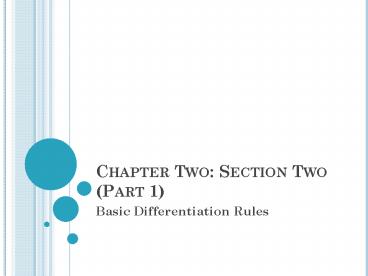Chapter Two: Section Two Part 1 - PowerPoint PPT Presentation
1 / 22
Title:
Chapter Two: Section Two Part 1
Description:
At time t = 0, a diver jumps from a diving board. Her position is given by ... What is the diver's initial velocity? What is the height of the diving board? ... – PowerPoint PPT presentation
Number of Views:47
Avg rating:3.0/5.0
Title: Chapter Two: Section Two Part 1
1
Chapter Two Section Two (Part 1)
- Basic Differentiation Rules
2
Overview
- In 2.1 we found derivatives using the formal
limit definition. - In this section, we will learn differentiation
rules so that we can find a derivative without
using the limit notation.
3
Constant Rule
- Focus on the graph of y 3. What is the slope
of this line? - What is the slope of any horizontal line?
4
Development of basic rules
- What is the slope at any point on the line
- y 4x 1?
- Use the definition of the derivative to find the
formula for the slope at any point on the line - y 2x2 1.
- Is there a quicker way to get this answer?
- Find the formula for the slope at any point on
the line y 3x3 4x2 6x 12.
5
The rules
- Power Rule
- Constant Multiple Rule
6
Example 1
- Find for the following
7
Example 2
- What is the equation of the tangent line to the
graph of y x6 at (2, 64)?
8
Example 3
- Use any applicable rules to find .
9
Sum difference rule
10
Example 4
- Find for the following function
11
Derivatives of Sine and Cosine Functions
- In order to generate our derivatives for sine and
cosine, we need to focus on the following Special
Trig limits (from Chapter 1)
12
Can You Find the Derivative Formulas For
13
Example 4
- Find
14
Homework (Part 1)
- 2.2
- p.110
- 2, 4, 12, 15, 16,
- 20, 21, 26, 41, 45
15
Chapter Two Section Two (Part 2)
- Rates of Change
- (Position, Velocity, Acceleration)
16
Derivatives are used
- to determine the rate of change of one variable
with respect to another. - For example
-
17
Lets Examine a Change in Position
- Graphically
- Rate of Change of Position over Time
-
-
S(t)
feet
seconds
t
t ?t
Average Velocity (Between 2 points)
18
Example 1
- A ball is dropped from a height of 150 feet. Its
height at time t is given by
, where s represents ft and t represents
seconds. - Find the average velocity from 1,2, 1, 1.5,
1, 1.1
19
Average Versus Instantaneous Rates
- On a previous slide we defined AVERAGE VELOCITY
(between 2 points) as - INSTANTANEOUS VELOCITY (at one point) is defined
as
The word average indicates the slope formula.
- Velocity at a point is the derivative of
Position. - Velocity tells rate and direction.
- Speed is the absolute value of velocity.
20
General Position Formula
Acceleration due to gravity Either -32 ft/sec2
or -9.8 m/sec2
Initial Velocity
Initial Position
21
Example 2
- At time t 0, a diver jumps from a diving board.
Her position is given by - (where s is in ft and t is in seconds).
- What is the divers initial velocity?
- What is the height of the diving board?
- When does the diver hit the water?
- What is the velocity at impact?
22
Homework (part 2)
- 2.2
- p. 111 112
- 48, 51, 63, 64, 68, 69, 71































